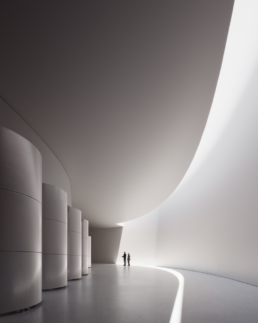New project | Dominio D’Echauz Winery
02/05/2025
In the quiet interior of Castilla, an architectural piece emerges—not one that imposes itself, but one that gently settles into the landscape. More than a typical winery, it is conceived as a place for the research and recovery of ancestral grape varieties.
This is a space where, through a process of microvinification, small experimental productions are crafted to evaluate the potential of forgotten or unclassified vines. Like a kind of winemaking Noah’s Ark, the winery not only hosts the research of Vitis Navarra but also safeguards and preserves the genetic biodiversity of grapevines in Spain, including species that still survive on the margins of the landscape and time.
The architecture gently rests on the topography of Zayas de Báscones, blending with the geometries of the land and the slow rhythm of cultivation. The two curved walls that structure the winery are inspired by the layout of the surrounding vineyards and their terrain, generating an enclosure that defines the space and allows it to be built in a natural way.
The longitudinal layout of the proposal follows the sequence of the wine production process: from the arrival of the grapes and destemming, through fermentation in steel tanks, aging in oak barrels, and finally, bottling. This linear path expands at specific points to integrate a social and tasting area, as well as spaces dedicated to research and storage, always maintaining the functional logic of the winemaking process. These walls, built with hempcrete blocks—a mix of plant fibers, lime, and water—laid on edge, gain greater structural inertia thanks to their curved geometry and are reinforced by a lightweight, single-pitch metal roof. All construction elements are unified through a continuous projection of white Diathonite, a natural cork-based mortar used on walls, floors, and ceilings. This system not only contributes to a unified and natural appearance but also provides significant thermal inertia, essential for maintaining stable interior conditions and supporting the optimal development of the wine during its aging process.
The Basajaun collection, named after the mythological figure who protected the forest, represents a space of transition: between what is known and what is yet to be discovered, between the agrarian past and a new way of understanding the relationship between architecture, nature, and wine culture. It is not only about storing wine, but about preserving life, diversity, and memory. A contemporary refuge for the ancient wisdom of the vine.






